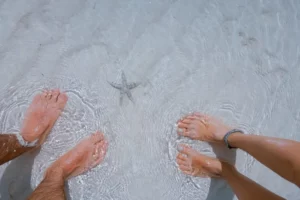[vc_row][vc_column][vc_column_text]The purpose of my blog series is to provide a comprehensive armoury to the everyday folk who suffer with heel pain, by helping them to identify the potential causes and components to their pain in order to help them effectively treat it in a pragmatic way.
I aim to dispel any myths around quick fixes and ineffective treatments and products and to give people informed choice regarding advanced therapies if they have failed to respond to conservative treatment approaches.
Part 1: Heel Pain: The ‘perfect storm’ and ‘the straw that broke the camel’s back!’
The human body is an incredible piece of machinery. It relies on the synchronisation of all its systems to produce energy and movement and then responds to changes in its internal and external environments to maintain a relatively stable equilibrium or “set point”. In physiological terms this is referred to as homeostasis.
Recreational sportsmen and women and competitive athletes alike, regularly challenge their bodies and positively influence their “set point” through consistent training and inversely through lack of training which leads to deconditioning.
Using the notion that our bodies function around a set point, it is no surprise that any dramatic deviation from it might lead to a system failure!!! (Or an injury!!!)
Now, consider injury as a ‘perfect storm!’
By definition “an especially bad situation caused by a combination of unfavourable circumstances”
(For the purpose of this blog, I’m not referring to injuries of a traumatic nature, like those caused by being run over by a bus or falling from a tree!)
The “circumstances” might include; muscle weakness, poor flexibility, weight, training, joint arthritis, inadequate footwear, occupation, training error, poor form, history of injury etc you get the picture! As mentioned previously, the human body is pretty good at functioning within certain parameters or around its ‘set point’ no matter what it’s inadequate makeup is. The problems arise, however, when it is forced to function outside of these parameters.
Now here’s the kicker, any change to a single variable may move the body out of its “zone of equilibrium” or “non injured zone”. This change might only be subtle but significant enough to cause one of the musculoskeletal mechanisms to fail!
BOOM, injury!
I refer to this as ‘the straw that broke the camel’s back.’
Now, this concept is important to the rest of this blog series! Why might you ask? Because we too often focus on treating the ‘straw that broke the camel’s back’ and fails to consider the other circumstances of the ‘perfect storm!’
Addressing the straw alone is often not enough to move the body back into its non-injured zone! Furthermore, disregarding the other circumstances usually leads to a poor response to treatment or an endless cycle of re-injury.
Active Step Podiatry is based in Whiteley, Hampshire covering Fareham, Southampton & Portsmouth. [/vc_column_text][/vc_column][/vc_row][vc_row][vc_column][vc_empty_space height=”40px”][ult_buttons btn_title=”Click Here to Read Part 2″ btn_link=”url:https%3A%2F%2Fwww.activestep.co.uk%2Fheel-pain-part-2%2F|title:Heel%20Pain%20Part%202||” btn_align=”ubtn-center” icon_size=”32″ btn_icon_pos=”ubtn-sep-icon-at-left”][vc_empty_space height=”40px”][/vc_column][/vc_row]



